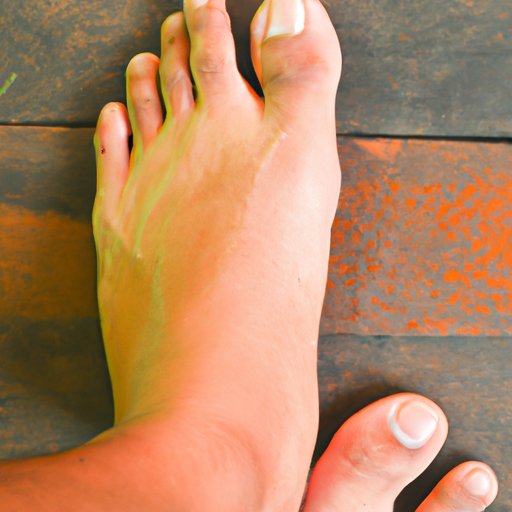
I. Introduction
Have you ever stubbed your toe so hard that you were left wondering if it was broken? It’s a common injury, but one that can be difficult to diagnose on your own. In this article, we’ll discuss the symptoms to look out for, diagnostic tools that can be used, and treatments available for broken toes. We’ll also provide some alternative remedies for soothing the pain.
II. Symptoms to Look Out for
The most common symptoms of a broken toe are severe pain, swelling, discoloration, and tenderness to the touch. The pain can be excruciating and may make it difficult to walk or put any pressure on the injured toe. If you notice any of these symptoms, you should take the necessary precautions to avoid further injury.
One way to identify whether your toe is broken is the “wiggle test.” Try to wiggle your toe back and forth gently. If you can move it easily, it’s less likely to be broken. If your toe won’t move or only moves slightly, it’s a sign that you should seek medical attention.
III. X-Ray as a Diagnostic Tool
X-rays are commonly used to diagnose a broken toe. This diagnostic tool allows doctors to take a closer look at the bones and joints and identify any damage. During an X-ray, you’ll need to place your foot on a special plate, and the technician will take images from different angles. The entire process is quick and painless, and the results will be available within a few hours.
One of the benefits of an X-ray is that it can identify the type and severity of the fracture, which can help your doctor determine the best course of treatment. It can also confirm whether a joint is dislocated or if there’s a foreign object in your foot that may be causing the pain.
IV. Watch for Deformities
If recent trauma or injury to your toe has caused it to deform, such as bending or twisting at an unusual angle or becoming misshapen, that’s another indication that you may have a broken toe. If you notice these symptoms, it’s important to seek medical attention promptly to prevent further damage to the toe or surrounding structures.
V. The RICE Method for Treating Fractures
The RICE method is an effective treatment for fractures and sprains, including those of the toe. If you suspect that your toe is broken, start the treatment immediately. The RICE method consists of:
- Rest – Avoid putting pressure on the injured toe and rest as much as possible.
- Ice – Apply ice packs to the affected area for 10 to 15 minutes every hour for the first 24 hours.
- Compression – Use an elastic bandage or wrap to compress the foot, but not so tightly that it restricts circulation.
- Elevation – Keep your foot elevated above your heart level whenever possible to reduce swelling and promote healing.
If you have a more severe break, your doctor may recommend a cast or splint to immobilize the affected toe or foot. Surgery may also be required in rare cases.
VI. Precautions You Should Take Before Diagnosing Your Broken Toe
While it can be tempting to try to self-diagnose your broken toe, it’s important to avoid this. If you suspect you have a broken toe, consult with your doctor before taking any action. They will be able to give you a proper diagnosis and recommend an appropriate course of treatment.
VII. How to Properly Splint Your Toe
If your doctor recommends splinting your toe, you can do it yourself at home. Here’s how:
- Place sterile gauze between the toes to keep them separated.
- Wrap an elastic bandage around the base of the toes.
- Use a tongue depressor or popsicle stick to immobilize the toe.
- Finish by wrapping the elastic bandage around the popsicle stick/tongue depressor and the base of the foot.
The goal of splinting is to keep the toe immobilized while it heals. If you experience any discomfort or increased swelling while splinting, remove the splint and consult with your healthcare provider.
VIII. Alternative Remedies for Soothing Broken Toes
In addition to the RICE method and medical treatments, there are some alternative remedies that can help soothe the pain of a broken toe. These include:
- Soaking your foot in warm water with Epsom salts
- Applying a balm or salve to the affected area
- Taking over-the-counter pain relievers
It’s important to note that these remedies may provide temporary relief, but they won’t heal the fracture or eliminate the need for medical treatment.
IX. Conclusion
If you suspect that you have a broken toe, it’s important to seek medical attention promptly. Pay close attention to any symptoms such as severe pain, swelling, or discoloration. The RICE method can be an effective treatment for minor fractures, but if your injury is more severe, you may require advanced medical treatment. By taking the necessary precautions and following your doctor’s advice, you can recover from a broken toe and get back on your feet in no time.




